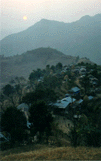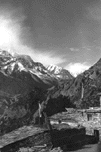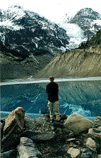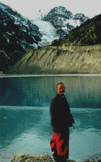


This massive granite cliff looms upwards as you begin the climb to enter the Manang valley above Chame.

Inside a typical lodge bedroom at Chame (2670m/8760ft) the temperature at night was a little nippy. Tracey here sporting her red nose is very pleased to own her lime green down sleeping bag. Getting out of them in the morning was a little difficult most days. The wooden panelling may well look warm and cosy, but the 2 inch gap under the door more than compensates with a chilly draught.

Ghyaru (3670m/12,041ft). This small village was half an hours walk plus an hours steep climb above the village of Pisang (3200m/10,500ft). By the time we got to the top it wasn't funny that the tables and chairs were on the roof of the tea-shop and we had to climb another three flights of stairs. The view is up the Manang valley with the Annapurna range on the left. Annapurna III (7555m/24,787ft) is climbing into the cloud at the immediate left edge. Gangapurna (7455m/24,459ft) is in the centre of the picture, left of the valley). The village buildings in the foreground are typical of this region, stone built with wooden cross beams, and with a flat stone roof. Hanging rather limply in the wind are a couple of Buddhist prayer flags, in fact rather less than you'll see in most villages!
Whilst supping our black tea and enjoying the view we were treated to two spectacles of nature. Firstly, two of the villages larger yak/buffalo/cow cross breads decided to have a full on fight - and one very small villager tried to come between them armed only with a thin steel tray and a handful of stones. The villager finally won out - without injury, and sent one animal packing with a volley of stones. In these parts a full grown bovine will cost about 33,000Rs when bought for meat (300GBP), so when considered with the likely wealth of the villager, you can see why he risked his hide to save the cows from each other's horns. The women of the family just laughed hysterically at the whole episode, and then carried on painting their toe-nails a gairish pink.
Secondly we were overflown by an as yet un-identified bird of prey with a large wing-span and beautiful golden feathers.

Pisang Peak rises above the villages of Pisang at the lower end of the Manang Valley. Its termed a 'trekking' peak which means that its reasonably easy to gain access to climb it. You pay £200 for a group permit, but you must also hire porters, guides, and a sirdar (overseer). They have also been termed 'limited bureaucracy peaks'. This view is from Ongre (further up the valley) looking towards Pisang which is to the right, just around the corner. The electricity pylons (which spoil the mid-ground) supply Manang, Ongre and Pisang from a small hydro-power station. Its so small that in the season the power is switched between villages on alternate nights. The scrub vegetation in the foreground is typical of the whole Manang Valley. Apparently they successfully manage to crop a lot of potatoes here - I don't know how!.


The Gangpurna Lake being spoilt by a tourist. The Gangapurna Lake (3540m/11,614ft) is situated across the valley from Manang. It is seperated from the Marsyandi River by a 200ft wide moraine dam (which I'm standing on in the picture). In the background you can see the glacier leading down from the Gangapurna Peak (7455m/24,459ft). The rim of the lake is frozen over - which explains why "The World's Highest Boating Facility" was shut, that and the sub-zero temperatures. I certainly didn't fancy rowing across this lake, let alone falling in. There is another higher lake in the next valley, the Tilicho, at 4920m/16,142ft, but no-one is mad enough to try boating there - you'd need an ice-breaker.
Note the pathetic attempt at a beard!
Tracey is smiling so sweetly because this is the first unfrozen bit of water we've seen for a while - perhaps she could take a bath.

